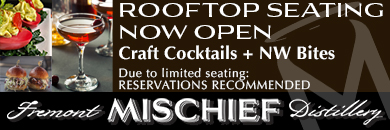by Kirby Lindsay, posted 23 October 2013

According to an October 13th article in The Seattle Times, for the first time in 15 years the Federal Communications Commission (FCC) will open the FM dial for thousands of new, low-power, noncommercial community stations across the country. The window for applications for these frequencies will be open briefly, although, as one of the scraps of silver linings created by the recent Federal government shut-down, the deadline has been extended to November 14th.
Fremont-based Brown Paper Tickets (BPT) has taken a primary role in this opportunity, by providing information, ideas and public funding sources for non-profits interested in launching into radio. Sabrina Roach, a BPT ‘Doer’, created and directs the ‘National Make Radio Challenge,’ offering hands-on help to fill the low-power FM (LPFM) frequencies with the sounds of our communities.
Community Dialogue, Amplified
The BPT Doers-program is an unlikely, innovative, philanthropic idea – professional advocates spend their working hours creating positive change in our communities as paid employees of this socially responsible company. (Read more in the Fremocentrist.com column from July 27, 2011.)
As a ‘Doer,’ Roach specializes in public media. With 11-years of experience in radio, having worked at KUOW and KBCS, Roach helps create events sparking interest in broadcasting, video and multi-platform media. She also has brought collaboration and community building to the LPFM application process.

“Radio can be the glue that sticks neighbors in the same room to talk and amplify that dialogue in the community,” Roach has said, “Helping nonprofits and educational institutions to claim a greater portion of the public airwaves will ultimately strengthen communities.”
Sharing Resources, And The Frequency?
Approximately 15 community groups have shown interest in launching community based radio stations. An LPFM station can reach a geographically limited listener base – approximately a 3-mile radius from the tower – as it broadcasts at 100 watts (KUOW broadcasts at 100,000 watts of power, according to the Seattle Times article.) The FCC will distribute licenses for stations based on availability in the market, “depending on which engineer you talk to, five to ten frequencies will be available within Seattle,” Roach acknowledged, which could lead to non-profits vying for a limited supply of licenses.
However, not every group has the resources to complete the complicated and demanding application. Then, the FCC can take up to two-years to process an application and, when given a permit, each organization has 18 months to fulfill the FCC requirements to get on-air.

Roach has encouraged groups to use this opportunity to build relationships and an infrastructure. Everyone can learn more, through this process, about broadcast and video resources, about how to write for on-line podcasts and streaming media, and using multi-platforms to share their message and their community with a broader public media audience.
An FCC license requires an LPFM station to produce 8 hours of local content a day for their first three years, Roach explained. However, those non-profits that get a license will have 24/7 broadcast potential – and the need for 24/7 content.
Taking History To The Air
History House of Greater Seattle hopes to help build content. John Nordstrand, Operations Manager for the Fremont-based museum, has been in discussions with a group looking to start a station for Ballard, Loyal Heights, Greenwood, Crown Hill, Queen Anne and Fremont.

Originally, Nordstrand heard of the opening of LPFM frequencies and thought about initiating a station out of the non-profit museum. “It was a relief for me,” he admitted recently, “when someone else wanted to do the dirty work,” as he jokingly referred to the application process, engineering and talks with lawyers about FCC requirements.
Nordstrand holds a degree in communications – for radio and television – and has broadcast experience. He can help run a station, but he’d really like to see History House help produce content. “We have an on-going interest in Emergency Preparedness,” he said, and the museum can share information it gathers on ways to prepare. “The second thing is the Victory Music part,” Nordstrand explained. History House has helped archive local, acoustic music recordings going back fifty years – which could be broadcast for the enjoyment of a broader audience.
Of course, “we’re a history museum – a city-wide history museum,” Nordstrand said, that shares the history of Seattle’s neighborhoods through volunteer efforts. Broadcast could be another way for volunteers to share those stories, and History House can provide a training ground and as liaison between the radio station and those capturing oral histories.

Nordstrand also acknowledged an interest at History House in creating a live broadcast platform – for the summer acoustic concert series Music In The Sculpture Garden, and other talks, discussions, and presentations on local history and informational topics.
Creating Alternative Communities On The Air
LPFM can give a variety of communities a stronger, even a louder, voice. Hollow Earth Radio, a community-run on-line radio station, could reach an even larger audience than it enjoys today by taking its forum for under-represented music and perspectives to the public airwaves – and those who don’t do ‘on-line.’ Another potential applicant, from the Little Mogadishu neighborhood of the City of Sea-Tac, would bring Somali culture and heritage to other immigrants, and the rest of our community.
The LPFM frequencies about to be distributed by the FCC are the legal equivalent of pirate radio frequencies – and can give a similar voice to the disenfranchised. To find out more about LPFM, and the National Make Radio Challenge, visit the Brown Paper Tickets website – and stay tuned!
Related Articles
- Walk The Art to Brown Paper Ticket’s Treehouse
- by Kirby Lindsay, July 27, 2011
- History House Seeks Fremont History From ‘Timber To Troll’
- by Kirby Lindsay, August 3, 2012
- MITSG: A Concert Series to Entertain, and Build Community
- by Kirby Lindsay, June 3, 2011
©2013 Kirby Lindsay. This column is protected by intellectual property laws, including U.S. copyright laws. Reproduction, adaptation or distribution without permission is prohibited.

